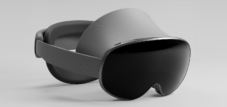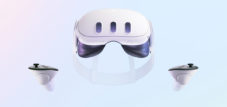Published on: March 29, 2025 / update from: March 29, 2025 - Author: Konrad Wolfenstein

Play for Dream MR: An innovative mixed reality headset (XR / VR glasses) in the premium segment-Image: Play for Dream / Pfdm.ai
The challenger in the mixed reality market: Play for Dream MR-HEADSET
Play for Dream MR: Competition for Apple's Vision Pro in the premium area
The Play for Dream MR headset has established itself on CES 2025 as one of the most surprising and impressive new additions in the field of mixed reality technology. This Android-based standalone headset combines high-quality hardware with a user-friendly design and positions itself as a serious competitor in the premium segment of the spatial computing market. With impressive 4K microoled displays per eye, a powerful Snapdragon XR2+ Gen 2 processor and a price below $ 2,000, the device offers an attractive alternative to established products such as the Apple Vision Pro. Particularly noteworthy are the high image quality, the improved wearing comfort through innovative weight distribution and the extensive compatibility with PC-VR applications. Although the design and the user interface are similar to Apple Vision Pro, the Play for Dream MR convinces with independent improvements and additional functions.
Suitable for:
Hardware and technical specifications
Display and visual quality
The Play for Dream MR is characterized by its impressive visual representation. With 4K microoled displays for each eye, the headset reaches a combined 8K resolution, which ensures extraordinary sharpness and detail. These high-resolution panels deliver deep black tones, lively colors and HDR support, which leads to an impressive contrast ratio. In tests on the CES 2025, users were impressed by the clarity and sharpness of the images, with some testers even reported that the image quality was better than with all other VR headsets in their possession.
The built-in pancake lenses offer a solid, if not perfect performance. In tests, slight problems with glare effects were found-more pronounced than with Meganex, but less noticeable than with bigscreen headsets. In addition, a significant chromatic aberration on the edges of the field of vision was observed, which can lead to rainbow -like distortion during eye movements. The horizontal field of vision is given at about 102 °, which is a bit wider than with comparable premium headsets such as the Megane Superlight 8k and offers a higher vertical field of vision than the Apple Vision Pro.
Processor and performance
The heart of the Play for Dream MR serves the Qualcomm Snapdragon XR2+ Gen 2 Chip, which is currently one of the most powerful processors for XR applications. This hardware platform enables sophisticated standalone applications as well as the processing of the complex sensor and camera data for mixed reality experiences. The performance of the chip supports the various interaction methods such as gaze and hand tracking as well as the processing of the high-resolution display content.
The technical equipment is completed by 11 cameras, 22 LED lights and seven different sensor types, which together enable precise recording of the environment and the user interactions. This extensive sensors forms the basis for mixed reality functionality, in which the outdoor cameras capture the surroundings and pass on the displays as a video image.
Tracking and control
The Play for Dream MR has integrated eye tracking that automatically scans and sets the user's individual eye distance (IPD). The inside-out tracking of the headset worked reliably in initial tests, with some smaller tracking problems on the CES being attributed to the high wireless interference on the trade fair area.
A significant difference to the Apple Vision Pro lies in the provision of dedicated controllers, which offer the user additional interaction options. These controllers have standard keys, according to testers, feel good in the hand and offer reliable performance. While the headset also supports the controls typical of spatial computing through gesture and pinch gestures, the controllers represent a valuable addition, especially for gaming applications.
Design and user comfort
Ergonomics and comfort
Despite a weight of around 650g, comparable to the Apple Vision Pro, the Play for Dream MR convinces with its superior weight distribution. With a ratio of 3: 2 between the front and back, the design significantly reduces the pressure on the face of the wearer. The battery is strategically positioned in the rear headband, which contributes to a balanced weight distribution and improves comfort, especially in the case of longer usage sessions.
The use of a plastic outer shell instead of glass, as is the case with the Apple Vision Pro, also contributes to the feeling of less weight. The magnetically fastened, interchangeable face pads underline the quality standards and enable individual adaptation to different facial forms. Testers on the CES 2025 reported that the headset was convenient enough for several hours of use-an important factor for the targeted gaming target group.
Audio quality
Due to the loud surroundings on the CES, the audio properties of the headset could not be extensively tested. However, the integrated speakers seem to be inspired by the design of the Apple Vision Pro. If you offer a similar quality, the audio component could also be a strength point of the device, but this remains to be checked in quieter test environments.
Software ecosystem and functionality
Operating system and user interface
The Play for Dream MR runs on a proprietary Android 14-based operating system. The user interface has strong similarities to Apple's visionos, which can be seen as a strength as well as a potential problem. From circular icons to window manipulation through view and pinch gestures-the inspiration through Apple's solution is unmistakable.
The company hopes to be able to replace its Android Fork with Google's Android XR in the future, provided that an agreement can be achieved with Google. This change could be done via an over-the-air update and potentially enable access to a wider application ecosystem.
Application compatibility and gaming
A special focus of the Play for Dream MR is on gaming applications. The headset not only supports standalone VR applications, but also offers extensive PCVR compatibility. In tests on the CES, games such as Half-Life: Alyx were streamed over Steamvr, whereby the visual quality was described as impressive-sharp, lively and with the typical OLED brilliance. However, a noticeable latency was also noticed that affected the gaming experience. The wireless streaming could not be tested at the fair due to WLAN interference, but is considered an important function for future evaluations.
In addition to support for SteamVR, the company advertises compatibility for over 6000 Steam games. In addition, the system enables up to five windows to increase at the same time, which should increase productivity. The integration with Windows laptops, which allows the project of screening onto the headset, are also a useful feature for productivity applications.
Suitable for:
- Samsung Android XR-Headset Project Moohan Premiere at the Mobile World Congress (MWC) 2025 in Barcelona
Market launch and positioning
Pricing and availability
The Play for Dream MR is said to be on the market at a price of less than $ 2,000, which is positioned in the premium segment, but significantly below the price level of the Apple Vision Pro. The first market launch is planned for October, initially in China, Singapore and Malaysia. A successful Kickstarter campaign with 215 supporters already earned the company $ 291,773. The delivery to Kickstarter supporters is planned for March 2025, with the regular start of sales shortly afterwards.
Challenges and market opportunities
The eye -catching similarities to the Apple Vision Pro could lead to legal challenges, especially when trying to expand into western markets. Without significant changes to the user interface, the company could be confronted with patent disputes. However, a simple redesign of the user interface or the takeover of Android XR could possibly solve these problems.
Despite these challenges, Play for Dream is strategically positioned in the growing market for spatial computing. With a price under that of the Apple Vision Pro, the delivery of controllers and the native support for SteamVR, the headset offers functions that are missing from the competition or are only available to a limited extent.
Expert opinions and experience reports
The reactions of experts who were able to test the Play for Dream MR on the CES 2025 were mostly positive. Uploadvr described it as “The Most Impressive XR Hardware of Any Kind at Ces 2025”, while Sebastian von MRTV awarded the device the title “MRTV XR Device of Ces 2025”. The image quality was particularly emphasized, with clear and sharp pictures from edge to edge.
In the case of more detailed tests, some weaknesses were also identified: In addition to the latency already mentioned in PCVR streaming and chromatic aberration on the edges, the binocular overlap was described as good, but not as seamless as with the Megane Superlight 8k. Nevertheless, the positive impressions, especially with regard to the visual quality and the carrying system, predominated.
Competition for Apple? The Play for Dream MR and its chances in the premium market
The Play for Dream MR presents itself as an ambitious newcomer to the premium segment of the Spatial Computing market. With its impressive hardware specification, the high display quality and the well thought-out ergonomic design, it has the potential to challenge established providers. The focus on gaming applications and PCVR compatibility could help the headset to find its own niche instead of competing directly with the Apple Vision Pro.
However, the obvious design and interface similarities with Apple's flagship product raise questions about originality and possible legal consequences. For long -term success, especially in western markets, Play for Dream may have to make adjustments in order to differentiate themselves more clearly.
Overall, the Play for Dream MR represents an interesting development in the rapidly growing XR market. With its price-performance ratio, gaming focusing and the solid technical basis, it could be an attractive option, especially for technology-savvy users and VR enthusiasts, provided the current vulnerabilities can be remedied until the market start.
Suitable for:
Your global marketing and business development partner
☑️ Our business language is English or German
☑️ NEW: Correspondence in your national language!
I would be happy to serve you and my team as a personal advisor.
You can contact me by filling out the contact form or simply call me on +49 89 89 674 804 (Munich) . My email address is: wolfenstein ∂ xpert.digital
I'm looking forward to our joint project.













